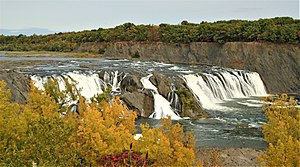
Back نهر موهاوك ARZ موهوک چایی AZB Mohawk River (suba sa Tinipong Bansa, New York) CEB Мохок (юханшыв) CV Mohawk (flod) Danish Mohawk River (New York) German Río Mohawk Spanish Mohawki jõgi Estonian Rivière Mohawk French Mohawk (rivier yn New York) Frisian
| Mohawk River | |
|---|---|
 | |
 Hudson River watershed map showing the Mohawk River | |
| Etymology | Named for Mohawk Nation |
| Native name | Teionontatátie (Mohawk) |
| Location | |
| Country | United States |
| State | New York |
| Regions | Central New York, Capital Region |
| Counties | Oneida, Herkimer, Montgomery, Schenectady, Albany, Rensselaer, Saratoga, |
| Cities | Rome, Utica, Little Falls, Amsterdam, Schenectady, Cohoes |
| Physical characteristics | |
| Source | East Branch Mohawk River |
| • location | S of Mohawk Hill |
| • coordinates | 43°30′51″N 75°28′02″W / 43.5142362°N 75.4671217°W[1] |
| 2nd source | West Branch Mohawk River |
| • location | W of West Branch |
| • coordinates | 43°22′12″N 75°30′29″W / 43.3700696°N 75.5079556°W[2] |
| Source confluence | |
| • location | E of West Branch |
| • coordinates | 43°22′16″N 75°28′6″W / 43.37111°N 75.46833°W[3] |
| • elevation | 932 ft (284 m)[1][2] |
| Mouth | Hudson River |
• location | Border of Albany County, Saratoga County, and Rensselaer County, New York |
• coordinates | 42°45′39″N 73°41′13″W / 42.76083°N 73.68694°W[3] |
• elevation | 10 ft (3.0 m)[4] |
| Length | 149 mi (240 km)[5] |
| Basin size | 3,460 sq mi (9,000 km2)[6] |
| Discharge | |
| • location | Below Delta Dam |
| • minimum | 15 cu ft/s (0.42 m3/s)[7] |
| • maximum | 8,560 cu ft/s (242 m3/s) |
| Discharge | |
| • location | Cohoes[8] |
| • average | 5,908 cu ft/s (167.3 m3/s)[8] |
| • minimum | 6 cu ft/s (0.17 m3/s)[9] |
| • maximum | 200,000 cu ft/s (5,700 m3/s)[9] |
| Basin features | |
| River system | Hudson River |
| Tributaries | |
| • left | Lansing Kill, West Canada Creek, East Canada Creek, Caroga Creek, North Chuctanunda Creek, Alplaus Kill |
| • right | Oriskany Creek, Otsquago Creek, Canajoharie Creek, Schoharie Creek, Plotter Kill |
| Waterfalls | Cohoes Falls |
The Mohawk River is a 149-mile-long (240 km)[5] river in the U.S. state of New York. It is the largest tributary of the Hudson River. The Mohawk flows into the Hudson in Cohoes, New York, a few miles north of the state capital of Albany.[10] The river is named for the Mohawk Nation of the Iroquois Confederacy. A major waterway, in the early 19th century, the river's east-west valley provided the setting and water for development of the Erie Canal, as a key to developing New York. The largest tributary, the Schoharie Creek, accounts for over one quarter (26.83%) of the Mohawk River's watershed. Another main tributary is the West Canada Creek, which makes up for 16.33% of the Mohawk's watershed.
- ^ a b "East Branch Mohawk River". Geographic Names Information System. United States Geological Survey, United States Department of the Interior.
- ^ a b "West Branch Mohawk River". Geographic Names Information System. United States Geological Survey, United States Department of the Interior.
- ^ a b "Mohawk River". Geographic Names Information System. United States Geological Survey, United States Department of the Interior.
- ^ Mouth elevation derived from Google Earth search using GNIS mouth coordinates.
- ^ a b U.S. Geological Survey. National Hydrography Dataset high-resolution flowline data. The National Map, accessed October 3, 2011
- ^ "Mohawk River Watershed - NYS Dept. of Environmental Conservation - New York State Department of Environmental Conservation". dec.ny.gov. dec.ny.gov. 2019. Retrieved 31 May 2019.
data
- ^ "USGS 01336000 Mohawk River Below Delta Dam Near Rome NY". waterdata.usgs.gov. United States Geological Survey. Retrieved August 21, 2021.
- ^ a b "USGS 01357500 MOHAWK RIVER AT COHOES NY". waterdata.usgs.gov. United States Geological Survey. Retrieved November 3, 2014.
- ^ a b "USGS 01357500 Mohawk River at Cohoes NY". USGS. USGS. Retrieved 3 November 2014.
- ^ Mohawk River Archived 2005-03-18 at the Wayback Machine, The Columbia Gazetteer of North America